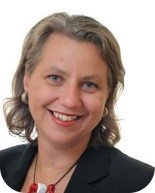Leading like Silicon Valley’s top leaders. Successful examples such as Google, Facebook & Co. are often considered as desirable and now seem to be within reach with the OKR system. Based on well-defined objectives and key results, this agile framework stands for successful corporate and employee management. It gives us the opportunity to react adequately to today’s flexible and insecure business world and allows us to find individual solutions for different challenges – together as a team. Agile leadership trainer Susanne Spath will give you a brief introduction to this topic.

Guest article
This article was written by Susanne Spath. She is an international trainer for managers and leaders and is working together with MDI for many years already. She is a certified SCRUM and OKR-Master and offers webinars and workshops in the field of agile leadership, SCRUM and OKR.
Where does the need for this agile method come from?
Our today‘s VUCA world (note: VUCA = Volatility, Uncertainty, Complexity, Ambiguity) is constantly changing. For a company, this means that it must be more flexible and future-oriented to cope with future challenges in the best possible way. One opportunity is to implement a new as well as approved method. OKR exists for over 10 years already and is used by companies such as Google, LinkedIn, and Twitter. However, the method is relatively new and unconventional.
OKR is an agile system and has a 100% transparent framework which helps you to set the right focus, to use resources in an output-oriented way, to make the right decision at the right time and to rethink about your tasks and goals.
- O’s (Objectives) – describe the target state
- KR´s (Key results) – describe concrete measurement criteria -> the „how“
A journey to Nice
To visualize this method, I would like to share a story with you I heard about in my OKR-Master training.
Imagine you and your friends spontaneously decide to go to the South of France. Everybody wants to have fun and wants to enjoy some unforgettable spring days together. Everyone gets on the bus. This is your vision.
Now you have to find the strategy how to get there: do we take the highway or the country road? Both have advantages, both involve some risks – you have to decide. Let’s say you take the country road because it is more charming. But: many people say that the French do not build any traffic lights. Instead, they have roundabouts, one after another. Additionally, there are no detailed signposts, only some with the next big cities such as Paris. So if you want to go to the South of France you have to decide at every roundabout, approx. every 500 meters, where to go. Sea or mountains? Somewhere quiet or fancy? You decide that you want to go to Nice. Therefore you have a focus as well.

In the past, you had maps which you could get in advance (alias business plan). But the road network and driving conditions are constantly changing. For your trip you have to get along with the idea of being in an uncertain situation: is the road passable when we get there? For sure we drive at full speed between the roundabouts. After 500 meters we can decide again which exit to take, which way to go. Perhaps to the excellent winery? But if we do so, we have one day less to spend at the beach – so should we leave it? Or does it start to rain? Now the thought and decision could be: before we spend some rainy days in Southern France, we rather go to the winery.
There are so many possibilities, again and again. The important thing is to make a common and flexible decision
Sources: Murakamy
OKR in a nutshell
Let us summarize where there are parallels between the story and the OKR thus for the company context:
- The vision is fixed but vague: a vacation in Southern France – in the company for instance: biggest supplier for the product x in area y.
- A focus is essential: trip to Nice – in the company for instance: focus on sale, focus on promotion or maybe the focus on product development
- The intermediate goals to realize the vision – the O’s, objectives – are constantly redefined: for the journey, for example, you have to decide at every roundabout which way to go. For a company, this could mean: which market do we focus on? Which department has the greatest leverage effect? What is the preferred product? In the story, you have to make a new decision every 500 meters. In the company, new decisions are made every 3 months at the leadership meeting. Participants are the management and representatives from various divisions.
- Key results are derived directly from the objectives and are measurable: in consideration of the current resources, concrete key results are defined up to the next quarter. On the way to Nice, this would be the tank filling and the fuel price, a decision about the winery or the tires of the car. In the company, there are concrete actions: sales training, advertising campaign, product redesign and so on.
Implementing OKR in the company
In contrast to many other agile methods, it doesn’t make sense to implement OKR in only a few teams or departments. There would be conflicts between the OKR and regular system regarding resources and objectives. A policy decision and commitment from the management are essential to implement the system successfully in a long-term.
Those are many:
- The company’s vision, mission, and strategy will be transmitted into short-term and therefore achievable steps
- An understanding of the big picture is given to every employee
- Rise of the clarity and understanding in the daily business
- Motivation through participation
- 100% transparency leads to better communication (everyone knows everybody’s tasks and can understand their objectives)
- Concrete and ongoing success measures
- Clear instructions are possible even with short resources.
What serves you next?
Video: agile leadership
The list of tools and concepts around agile leadership is long and often complex. Many companies are thinking about the implementation of agile methods in their own company. But what does agile leadership actually mean and is the implementation really reasonable?
Agile leadership on 3 levels
More and more companies are thinking about implementing agile methods. However, if you ask for more detailed information many people are not sure what the concepts mean for their company. Our trainer Alexandra Sock talks about agile leadership on three different levels: the individual, team and organization level.
Design Thinking - what's behind the hype?
Is Design Thinking “just” a new creative process? Only in the first moment – if you exploit its full potential, design thinking can be much more than that. We talked about this new and creative concept with our trainer Ursula Weixlbaumer-Norz.




